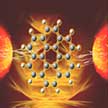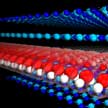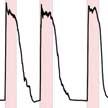Showing Spotlights 65 - 72 of 262 in category All (newest first):
 Ionic conductors are a class of materials with key roles in energy storage, solar energy conversion, sensors, and electronic devices. In their quest towards eco-friendly alternatives for the current type of ionic conductors, researchers have developed an alternative green option based on organic silk and inorganic green laponite for the display and wearables industry via flexible and eco-friendly ionics. This could ultimately enable a wide range of applications within the field of flexible and wearable electronics.
Ionic conductors are a class of materials with key roles in energy storage, solar energy conversion, sensors, and electronic devices. In their quest towards eco-friendly alternatives for the current type of ionic conductors, researchers have developed an alternative green option based on organic silk and inorganic green laponite for the display and wearables industry via flexible and eco-friendly ionics. This could ultimately enable a wide range of applications within the field of flexible and wearable electronics.
Mar 5th, 2019
 Sluggish electron transport kinetics - also known as aging - has hindered the application of graphene, for example, as transparent photodiode sensors in optoelectronics, graphites for effective use as oxygen reducing agents in fuel cells and so many other applications that involve fast heterogeneous electron transport and even increased capacitance. Scientists now report a breakthrough solution to the oxidation-induced sluggish electron transport in graphite (and even graphene).
Sluggish electron transport kinetics - also known as aging - has hindered the application of graphene, for example, as transparent photodiode sensors in optoelectronics, graphites for effective use as oxygen reducing agents in fuel cells and so many other applications that involve fast heterogeneous electron transport and even increased capacitance. Scientists now report a breakthrough solution to the oxidation-induced sluggish electron transport in graphite (and even graphene).
Jan 8th, 2019
 One of the most pervasive reliability problems facing the computer chip industry is ESD (electrostatic discharging) failure caused by the rapid, spontaneous transfer of electrostatic charge induced by a high electrostatic field. A novel above-IC graphene based nanoelectromechanical system (NEMS) switch structure for on-chip ESD protection utilizes the unique properties of graphene. This switch is a two-terminal device with a vacuum gap between a conducting substrate at the bottom and a suspended graphene membrane on top serving as the discharging path.
One of the most pervasive reliability problems facing the computer chip industry is ESD (electrostatic discharging) failure caused by the rapid, spontaneous transfer of electrostatic charge induced by a high electrostatic field. A novel above-IC graphene based nanoelectromechanical system (NEMS) switch structure for on-chip ESD protection utilizes the unique properties of graphene. This switch is a two-terminal device with a vacuum gap between a conducting substrate at the bottom and a suspended graphene membrane on top serving as the discharging path.
Dec 4th, 2018
 Traditional CMOS technology cannot be directly merged with graphene applications. Photo- and electron-based lithographies, which are the main processess in today's semiconductor industry, requires use of polymers and harsh liquids that can drastically alter the initial properties of graphene. Thus graphene requires the development of novel processing technologies.
A international team of researchers now has developed a method for direct, on-the-fly reconstruction of graphene properties.
Traditional CMOS technology cannot be directly merged with graphene applications. Photo- and electron-based lithographies, which are the main processess in today's semiconductor industry, requires use of polymers and harsh liquids that can drastically alter the initial properties of graphene. Thus graphene requires the development of novel processing technologies.
A international team of researchers now has developed a method for direct, on-the-fly reconstruction of graphene properties.
Jul 30th, 2018
 An international team of researchers has discovered a new mechanism for controlling electronic devices using molecules. The ferroelectric ordering of polar molecules attached to the edge of graphene can be toggle-switched by an electrostatic gate and can be used for memory devices and sensors. For this work, the team sandwiched graphene layers in hexagonal boron nitride crystals. The trick is to control the edge chemistry. The researchers attached different atoms to the graphene edges, before exposing them to water vapor and other polar molecules.
An international team of researchers has discovered a new mechanism for controlling electronic devices using molecules. The ferroelectric ordering of polar molecules attached to the edge of graphene can be toggle-switched by an electrostatic gate and can be used for memory devices and sensors. For this work, the team sandwiched graphene layers in hexagonal boron nitride crystals. The trick is to control the edge chemistry. The researchers attached different atoms to the graphene edges, before exposing them to water vapor and other polar molecules.
Jul 27th, 2018
 Researchers have developed a new process for completely transparent and flexible circuits of any patterns as one wishes. The circuit patterns are created via the well-developed microfluidic technology on transparent and flexible substrates. The conductors are generated by spin coating of silver nanowires along the patterns. The advance stimulates more implications in future electronics. The researchers have demonstrated a simple application of the circuits as a biosensor for glucose detection.
Researchers have developed a new process for completely transparent and flexible circuits of any patterns as one wishes. The circuit patterns are created via the well-developed microfluidic technology on transparent and flexible substrates. The conductors are generated by spin coating of silver nanowires along the patterns. The advance stimulates more implications in future electronics. The researchers have demonstrated a simple application of the circuits as a biosensor for glucose detection.
May 31st, 2018
 Very different from piezoelectric and other energy harvesting technologies, new research shows that water vapor or moisture expand the range of natural phenomena that can be used to generate electric power. Researchers demonstrate that moisture, a vast kind of resource existing ubiquitously on earth and in biological organisms, can be exploited as a novel harvestable energy to generate electricity. Although some device configurations previously have been demonstrated to directly generate electricity from moisture, these generators have not been shown yet to be flexible and to be used as self-powered wearable devices.
Very different from piezoelectric and other energy harvesting technologies, new research shows that water vapor or moisture expand the range of natural phenomena that can be used to generate electric power. Researchers demonstrate that moisture, a vast kind of resource existing ubiquitously on earth and in biological organisms, can be exploited as a novel harvestable energy to generate electricity. Although some device configurations previously have been demonstrated to directly generate electricity from moisture, these generators have not been shown yet to be flexible and to be used as self-powered wearable devices.
May 23rd, 2018
 Frequently, research by marine biologists depends on weighty and invasive sensory and telemetry equipment to understand and assess various aspects of the marine ecosystem. Researchers generally employ invasive attachment techniques to attach these devices to animals, sometimes restricting their natural movements. These tagging systems can be quite abrasive and not so forgiving on the animals. An alternative is a newly developed developed smart skin that integrates the main desired sensor arrays for continuously logging salinity/conductivity, temperature and depth in deep oceans.
Frequently, research by marine biologists depends on weighty and invasive sensory and telemetry equipment to understand and assess various aspects of the marine ecosystem. Researchers generally employ invasive attachment techniques to attach these devices to animals, sometimes restricting their natural movements. These tagging systems can be quite abrasive and not so forgiving on the animals. An alternative is a newly developed developed smart skin that integrates the main desired sensor arrays for continuously logging salinity/conductivity, temperature and depth in deep oceans.
May 7th, 2018
 Ionic conductors are a class of materials with key roles in energy storage, solar energy conversion, sensors, and electronic devices. In their quest towards eco-friendly alternatives for the current type of ionic conductors, researchers have developed an alternative green option based on organic silk and inorganic green laponite for the display and wearables industry via flexible and eco-friendly ionics. This could ultimately enable a wide range of applications within the field of flexible and wearable electronics.
Ionic conductors are a class of materials with key roles in energy storage, solar energy conversion, sensors, and electronic devices. In their quest towards eco-friendly alternatives for the current type of ionic conductors, researchers have developed an alternative green option based on organic silk and inorganic green laponite for the display and wearables industry via flexible and eco-friendly ionics. This could ultimately enable a wide range of applications within the field of flexible and wearable electronics. 
 Subscribe to our Nanotechnology Spotlight feed
Subscribe to our Nanotechnology Spotlight feed





